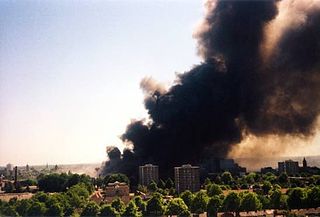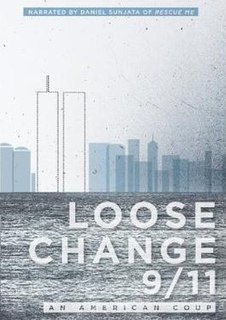
Newsreel footage of the 6 May 1937 Hindenburg disaster, where the zeppelin LZ 129 Hindenburg crashed and burned down, was filmed by several companies.

The Enschede fireworks disaster was a catastrophic fireworks explosion occurring at the S.E. Fireworks depot on 13 May 2000 at 13:00 GMT, in the eastern Dutch city of Enschede.

WLS-TV is a television station in Chicago, Illinois, United States, airing programming from the ABC network. Owned and operated by the network's ABC Owned Television Stations division, the station maintains studios on North State Street in the Chicago Loop, and its transmitter is located atop the Willis Tower.
Stock footage, and similarly, archive footage, library pictures, and file footage is film or video footage that can be used again in other films. Stock footage is beneficial to filmmakers as it saves shooting new material. A single piece of stock footage is called a "stock shot" or a "library shot". Stock footage may have appeared in previous productions but may also be outtakes or footage shot for previous productions and not used. Examples of stock footage that might be utilized are moving images of cities and landmarks, wildlife in their natural environments, and historical footage. Suppliers of stock footage may be either rights managed or royalty-free. Many websites offer direct downloads of clips in various formats.

WWE Classics On Demand was an American subscription video on demand television service provided by WWE. It featured footage from WWE's vast archive of wrestling footage, including classic WWE, World Championship Wrestling (WCW), Extreme Championship Wrestling (ECW) and more. It offered around 40 hours of rotating programming per month, arranged into four "programming buckets", often centered on a specific theme. It was originally called WWE 24/7 On Demand. In September 2008, it was changed to WWE 24/7 Classics on Demand. In April 2009, it was changed again to WWE Classics On Demand.
Action News is a local television newscast format originating in the United States. First conceived in Philadelphia, Pennsylvania, it is characterized by a tight format with strict time limits on set packages, a focus on surrounding suburbs, and a focus on young talent. It was a competitor to the Eyewitness News format.

Loose Change is a series of films released between 2005 and 2009 that theorize, based on evidence available about the 9/11 attacks, that 9/11 was a planned operation. The films were written and directed by Dylan Avery and produced by Korey Rowe, Jason Bermas, and Matthew Brown.

Deadliest Catch is a reality television series that premiered on the Discovery Channel on April 12, 2005. The show follows crab fishermen aboard fishing vessels in the Bering Sea during the Alaskan king crab and snow crab fishing seasons. The base of operations for the fishing fleet is the Aleutian Islands port of Dutch Harbor, Alaska. Produced for the Discovery Channel, the show's title is derived from the inherent high risk of injury or death associated with this line of work.

Mantra Films Inc., or Mantra Entertainment, was an American softcore pornography production company created by Joe Francis, chiefly for the production and distribution of the United States-based Girls Gone Wild and Guys Gone Wild media franchises.

The Apollo 11 missing tapes were those that were recorded from Apollo 11's slow-scan television (SSTV) telecast in its raw format on telemetry data tape at the time of the first Moon landing in 1969 and subsequently lost. The data tapes were used to record all transmitted data for backup.

Shockwave is an American documentary television series that premiered on November 30, 2007, on History. The program compiles video footage and eyewitness accounts to the headline making events and attempts to educate the viewer as to what really happened in a particular event.

The 2008 Atlanta tornado outbreak was a destructive and deadly tornado outbreak that affected the Southeastern United States on March 14–15, 2008. The most infamous tornado of the outbreak occurred on March 14 when an isolated, but strong, EF2 tornado caused widespread damage across Downtown Atlanta, including to the CNN Center and to the Georgia Dome,. Other buildings that were damaged include the Georgia World Congress Center, State Farm Arena, and the Omni Hotel, which was evacuated after many windows were blown out. The Westin Peachtree Plaza suffered major window damage. The image of the building with all the windows blown out became famous and, for a time, was the symbol of the tornado. Centennial Olympic Park, SunTrust Plaza and historic Oakland Cemetery were also damaged.

Koyaanisqatsi, also known as Koyaanisqatsi: Life Out of Balance, is a 1982 American experimental non-narrative film produced and directed by Godfrey Reggio with music composed by Philip Glass and cinematography by Ron Fricke.

102 Minutes That Changed America is a 102-minute American television special documentary film that was produced by the History channel and premiered commercial-free on Thursday, September 11, 2008, marking the seventh anniversary of the September 11 attacks. Its name comes from the timespan from the first impact of American Airlines Flight 11 and the collapse of the World Trade Center. The film depicts, in virtually real time, the New York-based events of the attacks primarily using raw footage from mostly amateur citizen journalists, focusing mainly on the reactions of New York inhabitants during the incident. The documentary is accompanied by an 18-minute documentary short called I-Witness to 9/11, which features interviews with nine firsthand eyewitnesses who captured the footage on camera.

Roombeek is a working-class suburb of the Dutch city of Enschede. It made international headlines due to the Enschede fireworks warehouse disaster on May 13, 2000. The warehouse explosion in Roombeek caused 23 deaths, and wounded 947 people. Around 400 homes were destroyed, and 1500 were seriously damaged by the fireworks explosion.

Lost television broadcasts are mostly those early television programs which cannot be accounted for in studio archives usually because of deliberate destruction or neglect.
Slow television, or slow TV, is a term used for a genre of "marathon" television coverage of an ordinary event in its complete length. Its name is derived both from the long endurance of the broadcast as well as from the natural slow pace of the television programme's progress. It was popularised in the 2000s by the Norwegian Broadcasting Corporation (NRK), beginning with the broadcast of a 7-hour train journey in 2009.

Fireworks in the Netherlands are mostly regulated by the Vuurwerkbesluit, a 1993 law that has subsequently been amended many times to make the rules surrounding the production, testing, transportation, storage, trade, sale, consumption and overall safety of fireworks stricter.
The Culemborg fireworks disaster occurred on Thursday 14 February 1991 in Culemborg, the Netherlands, on the border with the municipality of Vianen. A storage space for fireworks of the MS Vuurwerk BV company ignited and exploded. There were 2 deaths, 20 or 30 non-fatal injuries and the explosions caused heavy structural damage in a large surrounding area.














